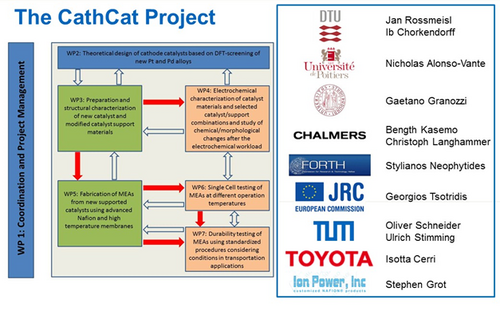Novel catalyst materials for the cathode side of MEAs suitable for transportation applications (CathCat)
The electrochemical oxidation of reactants in fuel cells represents, from a thermodynamic point of view, a very efficient way to convert chemical energy into electrical energy. When using hydrogen as fuel, fuel cells represent an attractive choice as power supply for electric vehicles, with zero local emissions and driving ranges around 500 km [1]. However, the true efficiency is much lower than the thermodynamically possible one. In low temperature proton exchange membrane fuel cells (PEM FCs) this is mainly due to the electrode reactions and especially to the sluggish kinetics of the oxygen reduction reaction (ORR) at the cathode [2, 3]. At present, there is demand for a significant increase in electrical efficiency and higher volumetric and gravimetric power densities of fuel cells. State-of-the-art catalysts for both anode- and cathode-side are based on noble metals, mainly Platinum. Especially in mass production, the platinum would significantly add to the total system cost. Also, the production of Pt is not sufficient for widespread implementation of the technology at current loadings. Finally, the lifetime of the fuel cells needs to be improved. These issues were addressed by the European research project CathCat that was funded by the Fuel Cells and Hydrogen Joint Untertaking (FCH JU) and coordinated by TUM.
In the CathCat project several European Universities and Research Institutes and two industrial partners collaborated in order to improve the performance and reduce the cost of PEM cathodes by development of new alloy catalysts based on Pt or Pd as one constituent and Rare Earth Elements as the second constituent. These alloys are known to form thick compressed Pt overlayers during initial de-alloying, leading to a significant enhancement of the catalytic activity [2, 4-6]. Within the project, the possible materials were screened by DFT methods for stability and activity as well as by studies on model alloys based on polycrystalline bulk alloys, single crystalline surface alloys and on thin films. Methods for the preparation of nanoparticles of those materials were developed and up-scaled for MEA production. In parallel, new support materials were explored based on functionalized carbons, carbon nanotubes and oxides.
A major challenge is the large scale synthesis of these alloys as nanoparticles for MEA fabrication. In our research group we aim at the electrochemical deposition of such alloys. In addition we collaborated with the University of Padova on the study of advanced support materials and the particle size effects of Pd nanoparticles deposited on HOPG and nitrogen-doped HOPG. These activities resulted in several publications [7-9].
References
[1] F.T. Wagner, B. Lakshmanan, M.F. Mathias, Electrochemistry and the Future of the Automobile, Journal of Physical Chemistry Letters, 1 (2010) 2204-2219.
[2] I.E.L. Stephens, A.S. Bondarenko, U. Gronbjerg, J. Rossmeisl, I. Chorkendorff, Understanding the electrocatalysis of oxygen reduction on platinum and its alloys, Energy & Environmental Science, 5 (2012) 6744-6762.
[3] A. Rabis, P. Rodriguez, T.J. Schmidt, Electrocatalysis for Polymer Electrolyte Fuel Cells: Recent Achievements and Future Challenges, ACS Catalysis, 2 (2012) 864-890.
[4] J. Greeley, I.E.L. Stephens, A.S. Bondarenko, T.P. Johansson, H.A. Hansen, T.F. Jaramillo, J. Rossmeisl, I. Chorkendorff, J.K. Nørskov, Alloys of platinum and early transition metals as oxygen reduction electrocatalysts, Nature Chemistry, 1 (2009) 552-556.
[5] M. Escudero-Escribano, A. Verdaguer-Casadevall, P. Malacrida, U. Grønbjerg, B.P. Knudsen, A.K. Jepsen, J. Rossmeisl, I.E.L. Stephens, I. Chorkendorff, Pt5Gd as a Highly Active and Stable Catalyst for Oxygen Electroreduction, Journal of the American Chemical Society, 134 (2012) 16476-16479.
[6] P. Hernandez-Fernandez, F. Masini, D.N. McCarthy, C.E. Strebel, D. Friebel, D. Deiana, P. Malacrida, A. Nierhoff, A. Bodin, A.M. Wise, J.H. Nielsen, T.W. Hansen, A. Nilsson, I.E.L. Stephens, I. Chorkendorff, Mass-selected nanoparticles of PtxY as model catalysts for oxygen electroreduction, Nature Chemistry, 6 (2014) 732–738.
[7] W. Ju, T. Brülle, M. Favaro, L. Perini, C. Durante, O. Schneider, U. Stimming, Palladium Nanoparticles Supported on HOPG: Preparation, Reactivity and Stability, ChemElectroChem, accepted (2014).
[8] W. Ju, M. Favaro, C. Durante, L. Perini, S. Agnoli, O. Schneider, U. Stimming, G. Granozzi, Pd Nanoparticles deposited on nitrogen-doped HOPG: New Insights into the Pd-catalyzed Oxygen Reduction Reaction, Electrochim. Acta, 141 (2014) 89-101.
[9] L. Perini, C. Durante, M. Favaro, V. Perazzolo, S. Agnoli, O. Schneider, G. Granozzi, A. Gennaro, Metal-Support Interaction in Platinum and Palladium Nanoparticles Loaded on Nitrogen Doped Mesoporous Carbon for Oxygen Reduction Reaction, ACS Applied Materials & Interfaces, dx.doi.org/10.1021/am506916y (2014).
